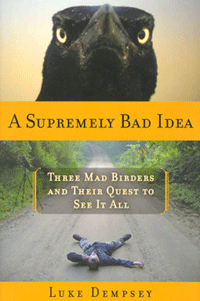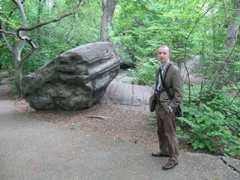The Mad Birder
Air Date: Week of September 12, 2008

A trio of birders hit the road on a gonzo journey in search of strange and exotic birds and have some bizarre experiences along the way. Host Bruce Gellerman speaks Luke Dempsey about the adventures he chronicles in his new book, “A Supremely Bad Idea: Three Mad Birders and their Quest to See It All.”
Transcript
GELLERMAN: There are two kinds of people: there are normal people, and then there are birders, people like Luke Dempsey. Luke Dempsey’s new book is called “A Supremely Bad Idea: Three Mad Birders and Their Quest to See it All.” Luke Dempsey joins me from a studio in New York City. Luke, welcome to Living on Earth.
DEMPSEY: Thanks for having me on. I really appreciate it.
GELLERMAN: You make a distinction between birding and bird watching.
DEMPSEY: Yeah, we try and do that, because we’re trying to give ourselves a pat on the back, I think. We call it birding because it sounds vaguely adventurous or a little bit exciting or maybe there’s an adventure or you know, something like that. Whereas bird watching just sounds so much like sitting in your back garden watching a bird at the feeder. So, we Americans, and I call myself that even though I’m not yet an American, we’re very into the verb.
GELLERMAN: Now, you’re not a born birder then. In the book, you suggest that maybe you are. You see a heron when you’re very young and you don’t tell anybody about it, but you’re captivated.
DEMPSEY: I did actually, when I was in my teens, I was taking a walk and I saw a grey heron, which is the equivalent of our great blue heron here, and I was taken with it immediately. It was the most beautiful thing. And sure enough I wasn’t going to tell anybody that. And then, when I moved to the United States, I had no interest in birds and I didn’t know anything about birds, and two friends of mine, Don and Donna Graffiti came up to my house in northeast Pennsylvania. And they knew I liked to hike and walk, and they were very sneaky. They handed me a pair of binoculars on the morning of our walk and just said, “you know if we see something maybe it’ll be fun, you don’t have to be a birder.” And, of course, at the time I would have rather gargled with hat pins than been a birder. But they showed me some birds in my garden, and it was as though scales were taken off my eyes. It was the most beautiful thing I’d ever seen, and I was lost to it immediately.
GELLERMAN: Now Don and Donna and you take a series of road trips in search of birds, lots of birds.
DEMPSEY: Well that’s – I never thought I’d sign up for that either. If I want to see a lot of different species, I need to go to a lot of different places. So we took a trip to – the first trip we took, was to Arizona, and I don’t think I quite understood going into this how insane Don and Donna are. I mean, I got into fights with guys in Florida, you know, we got involved with a smuggler in Texas.

Author Luke Dempsey
GELLERMAN: The minutemen in Arizona?
DEMPSEY: Oh then in Arizona, yeah, I got into an awful argument with a birding guide and I’m just waiting for a knock on the door and the burliest woman in the world comes and beats me with a stick. But a lot of the book is about birds, but a lot of it is about the sort of adventures we find ourselves in, the fights we find ourselves in. The entire state of Florida would probably never have me back. And so, that’s what we were trying to do. We were trying to entertain people, and thereby have people realize that birds are very beautiful and it’s not an expensive gig. You can go out and look at them with binoculars or without, but it’s a good thing to be doing.
GELLERMAN: But you don’t have to go far afield even in the United States or from New York to see fabulous birds.
DEMPSEY: New York City’s one of the greatest spots on the planet for birds. You know, Central Park for example, is a haven of green amongst all this concrete. And furthermore, it’s on the Eastern flyway. So the birds that are migrating from Central and South America will go up and over New York City. So New York City itself is incredible for birds. It’s also a place that heavily birded, so there are hundreds of birders.
GELLERMAN: You make a distinction between getting a bird versus seeing it. What’s the distinction?
DEMPSEY: Well – the distinction is – is not just linguistic. Too many birders, it seems to me, will get a bird. Which means they’ve seen it, they walk away. There’s a mall feel to it, as if they went to, you know, a local store and bought a view of the bird. For us, it’s something else. We find birds just so incredibly beautiful that even if there’s another live bird down the road, when we have one in our sights, we want to spend as much time as possible with it. Even to the point where dear Don Graffiti will start lapping. He literally goes [makes slurping sounds] because as he says he’s drinking the bird in. And we’ve had to explain that to a number of police officers around the country. But, I take his point, which is that if you see something beautiful, spend some time with it, that’s why we do it. And I’d rather spend two hours looking at an elegant trogon, than I would ever add just another bird to my list.

GELLERMAN: So you’re not a lister – or you are a lister?
DEMPSEY: Well, we try to say we’re not, but we are listers. We – I think all birders have that thing. It’s a very human thing to just keep a list of the things you’ve seen. Some birders are uber-listers, and that’s all they do. They would rather see something than really love on it. But we, you know, the reason we go to Colorado, the reason we got to Texas, the reason we went to Michigan -- I mean the reason we went to Michigan was to get the Kirtland’s Warbler, which is probably the rarest bird in America because it’s numbers are so tiny. And, we went with the express desire to see that one bird for our list.
GELLERMAN: What’s a life bird? I know there’s a term that birders use, but I’m not sure I understand it.
DEMPSEY: Yeah, I was talking to somebody recently who thought that once you get a life bird, you then immediately die.
[LAUGHING]
DEMPSEY: And it seemed to me a little – you know, that seemed a little excessive. A life bird is – I have never seen, let’s say, a red-necked stint, which right now is happily plying its trade in Jamaica Bay Wildlife Refuge, which is in Queens in New York City. And Don and Donna went to see it, got themselves a life bird. So once I’ve seen it and correctly identified it, it’s then a life bird.
GELLERMAN: Say Luke, if you could see one bird before you pass to that great nest in the sky what would it be?
DEMPSEY: It would probably be an ivory-billed woodpecker. And everybody keeps asking me about whether or not that bird exists, because they think I’m an expert on birds now. It may not exist. It may exist. But the mere fact that it could be alive in a swamp in Arkansas is a really big deal. And it may mean that we’ve started to do some things right with the environment, for example. It may mean that the work of citizens scientists – I mean this all came from citizen scientists, who went out there for the good of their own souls, not for anything else, to try to find a bird. I would love to go down there and just have one fly and perch on my head. And when it’s on my head it can do anything it likes. It can peck all day long. But I think it’s become a symbol for a lot of birders of a little bit of hope in terms of the environment and ecology.
GELLERMAN: Luke, before I let you go, I want to do your bird pishing.
DEMPSEY: Oh, good Lord. Well, I’m not a very good pisher. One has to be careful how one says that. Pishing is to bring a bird out of the undergrowth to look at you. The first bird I see in the book is the common yellowthroat, and that is a bird that is very susceptible to pishing. So on that day, we probably looked at the hedge row, and went…
[PISH-ING SOUNDS]
DEMPSEY: …and the birds for reasons unknown to all of us, thinks that’s really attractive, and will jump up and look at you and think, “My God, you’re completely crazy. You must be a birder.”
GELLERMAN: Luke Dempsey’s new book is called “A Supremely Bad Idea: Three Mad Birders and Their Quest to See it All”. I really appreciate it. Thank you so very much, Luke.
DEMPSEY: That was a real treat. Thank you so much for your time.
Links
To learn more about Luke Dempsey’s “Supremely Bad Idea,” click here
Living on Earth wants to hear from you!
Living on Earth
62 Calef Highway, Suite 212
Lee, NH 03861
Telephone: 617-287-4121
E-mail: comments@loe.org
Newsletter [Click here]
Donate to Living on Earth!
Living on Earth is an independent media program and relies entirely on contributions from listeners and institutions supporting public service. Please donate now to preserve an independent environmental voice.
NewsletterLiving on Earth offers a weekly delivery of the show's rundown to your mailbox. Sign up for our newsletter today!
 Sailors For The Sea: Be the change you want to sea.
Sailors For The Sea: Be the change you want to sea.
 The Grantham Foundation for the Protection of the Environment: Committed to protecting and improving the health of the global environment.
The Grantham Foundation for the Protection of the Environment: Committed to protecting and improving the health of the global environment.
 Contribute to Living on Earth and receive, as our gift to you, an archival print of one of Mark Seth Lender's extraordinary wildlife photographs. Follow the link to see Mark's current collection of photographs.
Contribute to Living on Earth and receive, as our gift to you, an archival print of one of Mark Seth Lender's extraordinary wildlife photographs. Follow the link to see Mark's current collection of photographs.
 Buy a signed copy of Mark Seth Lender's book Smeagull the Seagull & support Living on Earth
Buy a signed copy of Mark Seth Lender's book Smeagull the Seagull & support Living on Earth

